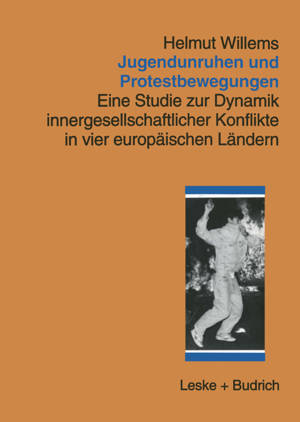
En raison d'une grêve chez bpost, votre commande pourrait être retardée. Vous avez besoin d’un livre rapidement ? Nos magasins vous accueillent à bras ouverts !
- Retrait gratuit dans votre magasin Club
- 7.000.000 titres dans notre catalogue
- Payer en toute sécurité
- Toujours un magasin près de chez vous
En raison de la grêve chez bpost, votre commande pourrait être retardée. Vous avez besoin d’un livre rapidement ? Nos magasins vous accueillent à bras ouverts !
- Retrait gratuit dans votre magasin Club
- 7.000.0000 titres dans notre catalogue
- Payer en toute sécurité
- Toujours un magasin près de chez vous
Jugendunruhen Und Protestbewegungen
Eine Studie Zur Dynamik Innergesellschaftlicher Konflikte in Vier Europäischen Ländern
Helmut Willems
Livre broché | Allemand
54,45 €
+ 108 points
Description
I. 11 1. Fragestellung und Gegenstand der Arbeit. . . . . . . . . . . . . . . . . . . . . . . . . . . 11 Die politische Relevanz des Themas . . . . . . . . . . . . . . . . . . . . . . . . . . . . . . . . . . . 2. 12 Die Relevanz fUr die soziologische Theorie . . . . . . . . . . . . . . . . . . . . . . . . 3. 13 Die empirischen Studien . . . . . . . . . . . . . . . . . . . . . . . . . . . . . . . . . . . . . . . . . . . . . . . . . . . . . . 14 4. U ntersuchungsgegenstand und theoretisches II. Instrumentarium . . . . . . . . . . . . . . . . . . . . . . . . . . . . . . . . . . . . . . . . . . . . . . . . . . . . . . . . . . . . 17 1. Forschungsfeld und Untersuchungsgegenstand . . . . . . . . . . . . . . . . . . 19 2. Erklarungsansatze der U rsachen und Entstehungsbedingungen nicht-institutionalisierter politischer Konflikte . . . . . . . . . . . . . . . . . . . . . . . . . . . . . . . . . . . . . . . . . . . . . . . . . . . . . . . . . . . . 19 2. 1 Die makro-soziologischen Ansatze der Konfliktforschung . . . . . . . 20 2. 1. 1 Marxistische Ansatze . . . . . . . . . . . . . . . . . . . . . . . . . . . . . . . . . . . . . . . . . . . . . . . . . . . . . . . . . . . . . . 20 2. 1. 2 Struktur-funktionalistische Ansatze . . . . . . . . . . . . . . . . . . . . . . . . . . . . . . . . . . . . . . . . . 21 2. 1. 3 Ein-Faktor-Ansatze . . . . . . . . . . . . . . . . . . . . . . . . . . . . . . . . . . . . . . . . . . . . . . . . . . . . . . . . . . . . . . . . . 22 2. 2 Sozialpsychologische Ansatze . . . . . . . . . . . . . . . . . . . . . . . . . . . . . . . . . . . . . . . . . . . . . . . . . 23 2. 2. 1 Deprivationstheorien . . . . . . . . . . . . . . . . . . . . . . . . . . . . . . . . . . . . . . . . . . . . . . . . . . . . . . . . . . . . . . . 23 Protest als Krisenreaktion . . . . . . . . . . . . . . . . . . . . . . . . . . . . . . . . . . . . . . . . . . . . . . . . . . . . . . . . 26 2. 2. 2 2. 2. 3 Wertwandelstheorien . . . . . . . . . . . . . . . . . . . . . . . . . . . . . . . . . . . . . . . . . . . . . . . . . . . . . . . . . . . . . . . 27 2. 3 Individualistische Ansatze . . . . . . . . . . . . . . . . . . . . . . . . . . . . . . . . . . . . . . . . . . . . . . . . . . . . . . . 28 2. 3. 1 Olson . . . . . . . . . . . . . . . . . . . . . . . . . . . . . . . . . . . . . . . . . . . . . . . . . . . . . . . . . . . . . . . . . . . . . . . . . . . . . . . . . . . . . . 29 2. 3. 2 Oberschall und Gamson . . . . . . . . . . . . . . . . . . . . . . . . . . . . . . . . . . . . . . . . . . . . . . . . . . . . . . . . . . 30 31 2. 3. 3 Wert -Erwartungs-Theorien . . . . . . . . . . . . . . . . . . . . . . . . . . . . . . . . . . . . . . . . . . . . . . . . . . . . . 2. 3. 4 Theorie der Ressourcenmobilisierung . . . . . . . . . . . . . . . . . . . . . . . . . . . . . . . . . . . . . . 33 Hirschmans Zyklus-Theorie des politischen Engagements . . . . . . 34 2. 3. 5 2. 4 Zwischenresiimee . . . . . . . . . . . . . . . . . . . . . . . . . . . . . . . . . . . . . . . . . . . . . . . . . . . . . . . . . . . . . . . . . . . . 35 Ansatze zur Analyse der Konfliktinteraktion und 3. Konfliktdynamik . . . . . . . . . . . . . . . . . . . . . . . . . . . . . . . . . . . . . . . . . . . . . . . . . . . . . . . . . . . . . . 36 5 3. 1 Die Ansatze der klassischen Massenpsychologie. . . . . . . . . . . . . . . . . . . . . 37 3. 1. 1 Le Bons Psychologie der Masse. . . . . . . . . . . . . . . . . . . . . . . . . . . . . . . . . . . . . . . . . . . . . . . 38 3. 1. 2 Freuds Identifikationsthese. . . . . . . . . . . . . . . . . . . . . . . . . . .
Spécifications
Parties prenantes
- Auteur(s) :
- Editeur:
Contenu
- Nombre de pages :
- 504
- Langue:
- Allemand
Caractéristiques
- EAN:
- 9783810018373
- Date de parution :
- 30-01-97
- Format:
- Livre broché
- Format numérique:
- Trade paperback (VS)
- Dimensions :
- 148 mm x 210 mm
- Poids :
- 598 g

Les avis
Nous publions uniquement les avis qui respectent les conditions requises. Consultez nos conditions pour les avis.






